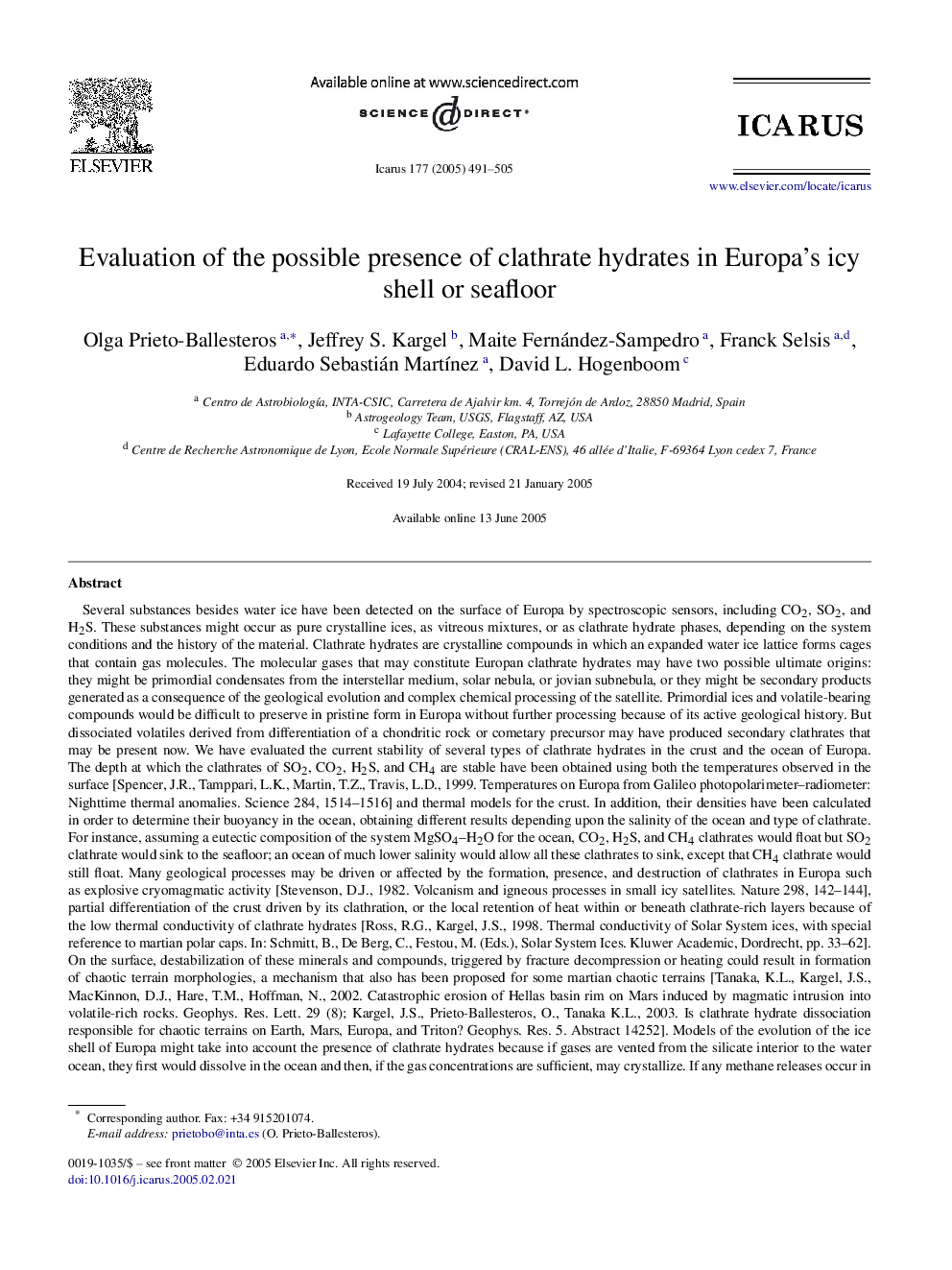| Article ID | Journal | Published Year | Pages | File Type |
|---|---|---|---|---|
| 10701935 | Icarus | 2005 | 15 Pages |
Abstract
Several substances besides water ice have been detected on the surface of Europa by spectroscopic sensors, including CO2, SO2, and H2S. These substances might occur as pure crystalline ices, as vitreous mixtures, or as clathrate hydrate phases, depending on the system conditions and the history of the material. Clathrate hydrates are crystalline compounds in which an expanded water ice lattice forms cages that contain gas molecules. The molecular gases that may constitute Europan clathrate hydrates may have two possible ultimate origins: they might be primordial condensates from the interstellar medium, solar nebula, or jovian subnebula, or they might be secondary products generated as a consequence of the geological evolution and complex chemical processing of the satellite. Primordial ices and volatile-bearing compounds would be difficult to preserve in pristine form in Europa without further processing because of its active geological history. But dissociated volatiles derived from differentiation of a chondritic rock or cometary precursor may have produced secondary clathrates that may be present now. We have evaluated the current stability of several types of clathrate hydrates in the crust and the ocean of Europa. The depth at which the clathrates of SO2, CO2, H2S, and CH4 are stable have been obtained using both the temperatures observed in the surface [Spencer, J.R., Tamppari, L.K., Martin, T.Z., Travis, L.D., 1999. Temperatures on Europa from Galileo photopolarimeter-radiometer: Nighttime thermal anomalies. Science 284, 1514-1516] and thermal models for the crust. In addition, their densities have been calculated in order to determine their buoyancy in the ocean, obtaining different results depending upon the salinity of the ocean and type of clathrate. For instance, assuming a eutectic composition of the system MgSO4H2O for the ocean, CO2, H2S, and CH4 clathrates would float but SO2 clathrate would sink to the seafloor; an ocean of much lower salinity would allow all these clathrates to sink, except that CH4 clathrate would still float. Many geological processes may be driven or affected by the formation, presence, and destruction of clathrates in Europa such as explosive cryomagmatic activity [Stevenson, D.J., 1982. Volcanism and igneous processes in small icy satellites. Nature 298, 142-144], partial differentiation of the crust driven by its clathration, or the local retention of heat within or beneath clathrate-rich layers because of the low thermal conductivity of clathrate hydrates [Ross, R.G., Kargel, J.S., 1998. Thermal conductivity of Solar System ices, with special reference to martian polar caps. In: Schmitt, B., De Berg, C., Festou, M. (Eds.), Solar System Ices. Kluwer Academic, Dordrecht, pp. 33-62]. On the surface, destabilization of these minerals and compounds, triggered by fracture decompression or heating could result in formation of chaotic terrain morphologies, a mechanism that also has been proposed for some martian chaotic terrains [Tanaka, K.L., Kargel, J.S., MacKinnon, D.J., Hare, T.M., Hoffman, N., 2002. Catastrophic erosion of Hellas basin rim on Mars induced by magmatic intrusion into volatile-rich rocks. Geophys. Res. Lett. 29 (8); Kargel, J.S., Prieto-Ballesteros, O., Tanaka K.L., 2003. Is clathrate hydrate dissociation responsible for chaotic terrains on Earth, Mars, Europa, and Triton? Geophys. Res. 5. 14252]. Models of the evolution of the ice shell of Europa might take into account the presence of clathrate hydrates because if gases are vented from the silicate interior to the water ocean, they first would dissolve in the ocean and then, if the gas concentrations are sufficient, may crystallize. If any methane releases occur in Europa by hydrothermal or biological activity, they also might form clathrates. Then, from both geological and astrobiological perspectives, future missions to Europa should carry instrumentation capable of clathrate hydrate detection.
Related Topics
Physical Sciences and Engineering
Earth and Planetary Sciences
Space and Planetary Science
Authors
Olga Prieto-Ballesteros, Jeffrey S. Kargel, Maite Fernández-Sampedro, Franck Selsis, Eduardo Sebastián MartÃnez, David L. Hogenboom,
